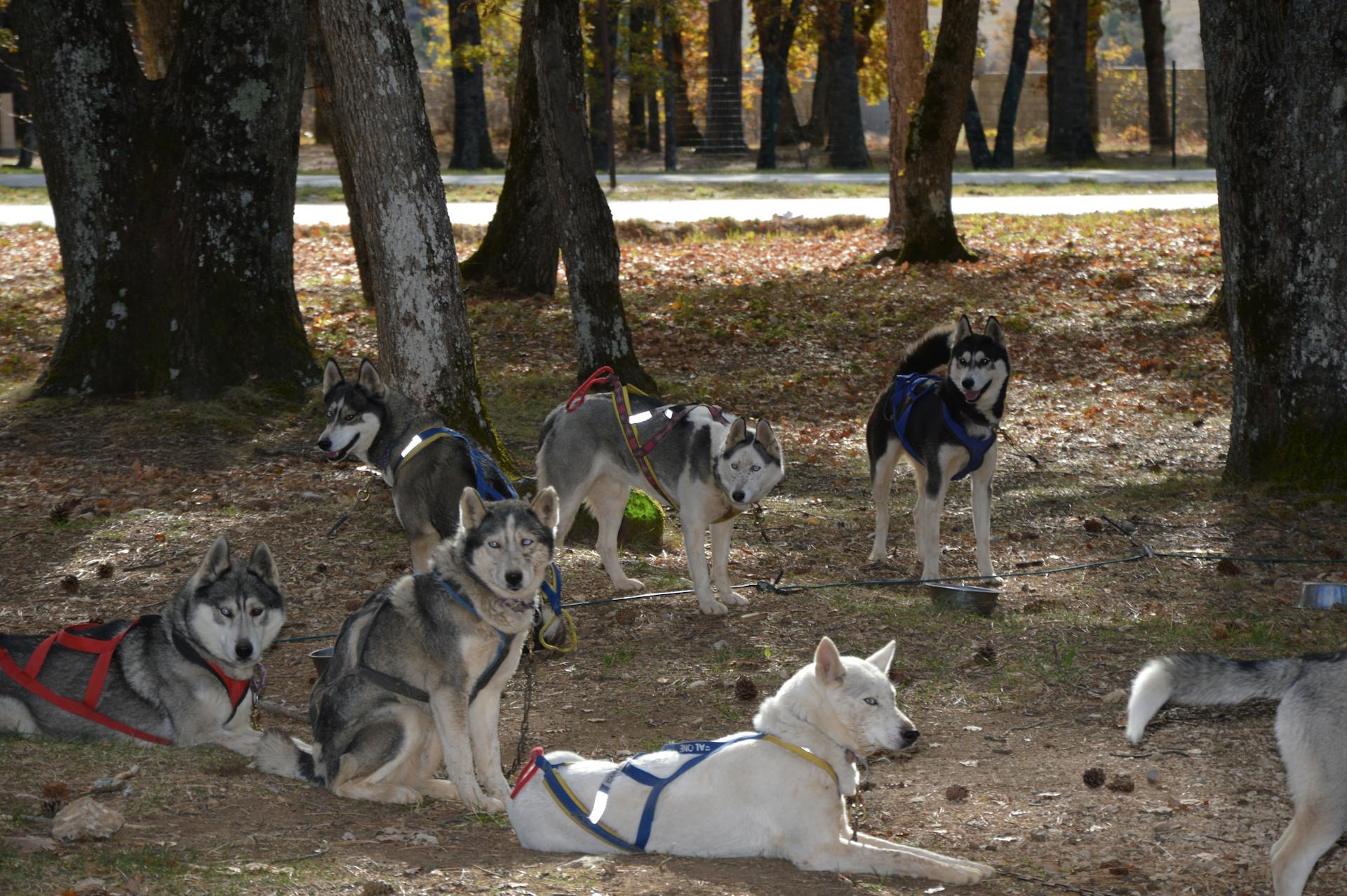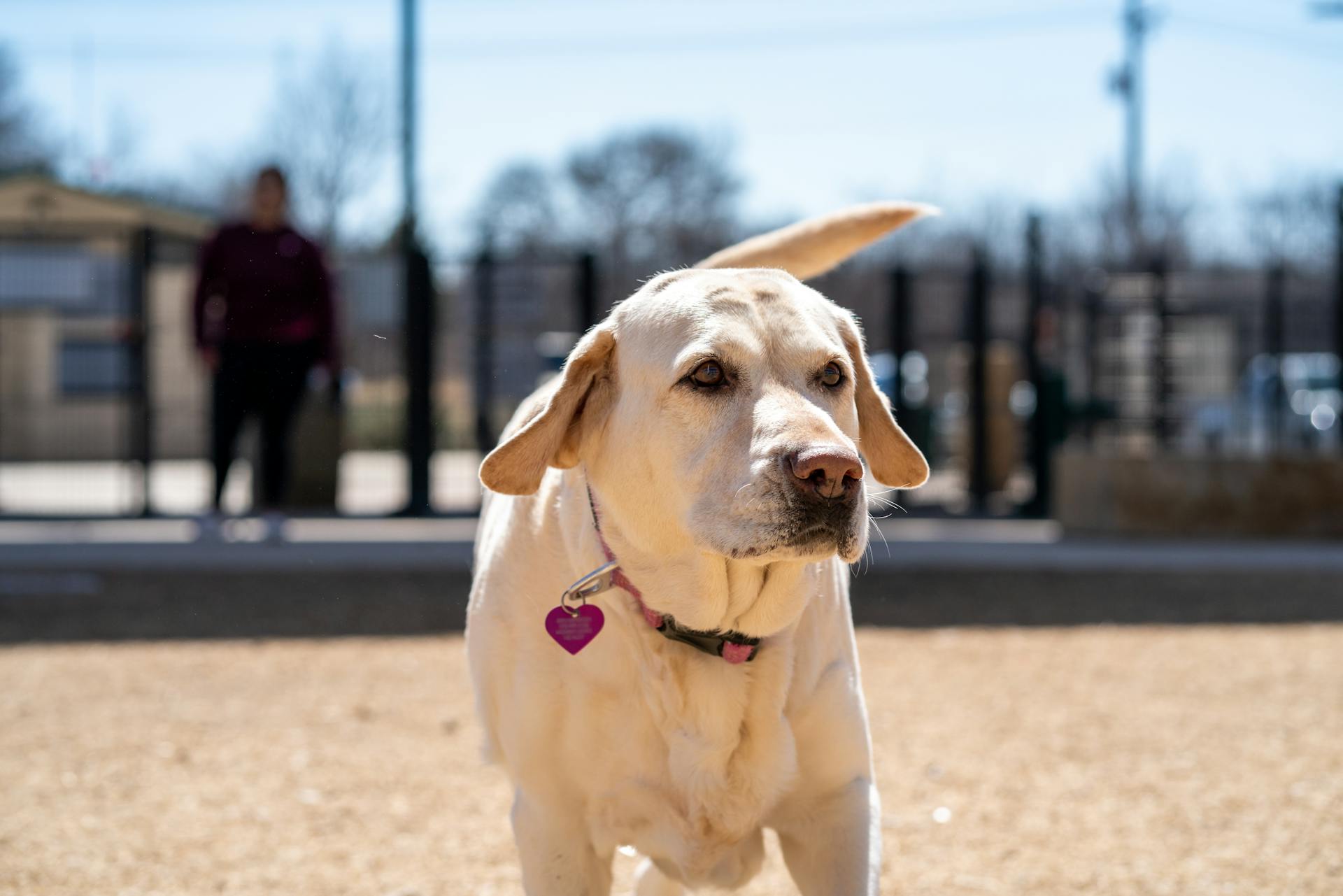
Dogs are indeed pack animals, and their social structure is fascinating. They were originally domesticated from wolves, which are highly social animals that thrive in packs.
Dogs have a hierarchical structure, with a dominant leader, often the alpha male or female, who makes key decisions for the pack. This structure is evident in their behavior, such as when they establish a pecking order.
In a pack, dogs work together to hunt, protect, and care for each other's young. They have a strong instinct to follow a leader and respond to vocal cues, which is a remnant of their wild ancestors.
Their social structure is also influenced by their evolution as companions, where they've learned to live alongside humans and adapt to their family dynamics.
Related reading: Pack Leader Dog Training
Canine Social Structure
Dogs are not strict pack animals like their wolf ancestors. They've undergone significant evolutionary and behavioral changes since domestication.
Their social structure is more flexible and fluid, influenced by interactions with humans and other dogs. This means they don't necessarily follow a hierarchical pack mentality.
In fact, dogs often form strong attachments to their human family, relying on them for companionship, guidance, and security. This is a key aspect of their behavior and temperament, shaped by socialization from puppyhood onwards.
The Pups
In wolf packs, the pups are a top priority, with the breeding pair often prioritizing their care and feeding them first in times of scarcity.
The pups have a high mortality rate, with only about 30% surviving their first year of life.
Raising the litter is a collaborative effort among all pack members, who contribute to the pups' development.
Pups are surrounded by numerous caretakers and teachers, which gives them an advantage in learning and growing.
This supportive environment allows them to learn valuable social skills from each member of the pack.
Pups learn from the elders of the group, who pass on the pack's culture and social structure to the next generation.
The social skills they acquire enable them to form powerful bonds with other pack members, which is crucial for the pack's overall structure.
Family and Social Groups
Dogs are highly social animals that form strong attachments to humans and other dogs.
Their primary social unit is often their human family, and they rely on their human caregivers for companionship, guidance, and security.
Dogs exhibit behaviors that reflect their desire to be part of a social group, and they often form loose social groups with other dogs.
In the context of domestication, dogs have adapted to form social bonds with humans and other animals in their environment.
Early socialization plays a vital role in shaping a dog's behavior and temperament, and exposing puppies to a wide range of experiences, people, and animals during their critical socialization period can help them develop into well-adjusted and confident adults.
Behaviour
Dogs are not trying to take over the pack or be in charge, they're just learning how to interact with their human family members.
Dogs are great students of human behavior and draw conclusions based on our actions, which is why punishment, deference, and fear as training methods can actually harm their mental and emotional well-being.
A mentally and emotionally healthy dog is not necessarily achieved with obedience training alone, but rather with socialization, positive reinforcement, and clear and predictable interactions.
For your interest: All about Dogs Dog Training
Punishment-based methods can lead to anxiety and fear-based responses in dogs, whereas positive reinforcement training promotes a trusting and cooperative relationship.
Here are some key differences between punishment-based and positive reinforcement training:
Dogs learn to communicate, interpret body language, and navigate complex social interactions through socialization, which begins in puppyhood and continues throughout their lives.
Dogs that think of themselves as the alpha or are trying to position themselves in that role may display disobedience or wilful behaviour, but this doesn't necessarily mean they're trying to fight for the position or show aggression.
Alpha, Omega and Hierarchy
Dogs are often referred to as pack animals, but what does this really mean? The term "alpha" is often used to describe the dominant dog in a household, but this concept has been widely discredited by modern research.
In wolf packs, the alpha pair is typically the genetic parents of most cubs in the pack, and they have exclusive access to mating females. However, this is not the case in domestic dog households, where the alpha role is often reserved for the dominant male and female.
Dogs will often include every member of the household as part of their pack, and owners should automatically take the alpha role. However, it's not uncommon to see small dogs taking the alpha role, even over larger dogs.
The idea of the "alpha dog" has been popularized in dog training literature, but it's based on outdated research and has been widely discredited. The term "alpha" adds no information and should be reserved for where the individuals are the predominant pack progenitor.
Here's a breakdown of the hierarchy:
- Alpha: The dominant male and female in the pack
- Omega: The dogs lower down in the pecking order
It's essential to understand that dogs are social animals and thrive in packs. In the wild, wolves and dogs rely on the power of the collective to survive and thrive. Domesticating dogs has taken them from their natural environment and isolated them from other dogs and pack members.
Wolves and Canine Evolution
Dogs descended from wolves, with domestication believed to have occurred between 20,000 and 40,000 years ago.
This domestication process led to significant changes in the behavior and social structure of wolves, giving rise to the diverse range of dog breeds we have today.
The social hierarchies of pack animals like wolves and dogs are deeply ingrained, guiding their logic and thinking, and our role as domesticators plays into this.
The history of human evolution shows that wolves domesticated humans, teaching us how to succeed and survive in an unforgiving world.
Specific Species
African wild dogs are a great example of pack behavior, living and hunting in groups where males assist in raising pups and stay with their pack for life. They even help care for wounded, sick, and young pack members.
In contrast, wolves tend to live in packs with adult parents and their offspring of the last two or three years. The adult parents are usually unrelated.
Gray wolves usually hunt in packs, but they also hunt alone in the spring and summer months when prey is plentiful. This flexibility is likely an adaptation to their environment.
Black-backed jackals and coyotes typically have a single long-term mate and usually hunt alone or in pairs. They only come together in larger packs to hunt big game.
The Ethiopian wolf is a unique example, where pack members hunt for rodents alone and come together mainly to defend their territory from rival packs.
The Evolution of
The Evolution of Wolves and Dogs is a fascinating story that spans thousands of years. Domestication of wolves into dogs is believed to have occurred between 20,000 and 40,000 years ago.
Humans and wolves formed mutually beneficial relationships, leading to significant changes in wolf behavior and social structure. This process gave rise to the diverse range of dog breeds we have today.
The domestication of wolves into dogs was a gradual process that likely began with wolves scavenging human trash and eventually leading to wolves being kept as companions. Wolves, the ancestors of dogs, are well-known for their pack behavior, which is crucial for hunting, raising offspring, and defending territory.
In the wild, wolves live in family groups called packs, which typically consist of a mated pair, their offspring, and related individuals. The pack structure is hierarchical, with each member having a specific rank and role within the group.
Dogs, as we know them today, are descendants of wolves, and understanding their evolutionary history is essential to understanding their social behavior. The breeding pair, often referred to as the "alpha pair", is typically the matriarch and patriarch of the family, and they breed and produce offspring.
African wild dogs, for example, live and hunt in packs, with males assisting in raising the pups and staying with their pack for life. They also cooperate in caring for wounded, sick, and young pack members.
Take a look at this: Are German Shepherds Good Pets
Understanding Canine Behavior
Dogs are not strict pack animals like their wolf ancestors, but rather exhibit a more flexible and fluid social structure influenced by their interactions with humans and other dogs.
Their domestication has taken them from their preferred state to an unknown place, and it's our responsibility as dog owners to define a clear social hierarchy with our dogs and model a pack mentality to promote comfort and collective wellbeing.
Dogs thrive in packs, and reconnecting them with their own species mentality can bring remarkable changes, as seen in a client I've worked with who had an older yellow lab that lacked energy and vitality.
In fact, a family with an older yellow lab was able to observe a profound shift in their dog's behavior when two puppies were placed in their home, allowing the dog to reconnect with its pack.
Understanding energetic cues and expressions in dogs is crucial to decoding their behavior and becoming a confident and peaceful leader capable of meeting their needs.
This involves becoming aware of canine energetic cues, fostering trust, respect, and empathy with our dogs, and ensuring they feel safe and valued.
The modern understanding of canine social behavior highlights the importance of considering their social nature and underlying motivations when addressing behavioral issues.
Punishment-based methods can harm the bond between a dog and its owner, leading to anxiety and fear-based responses, whereas positive reinforcement training promotes a trusting and cooperative relationship while effectively shaping desirable behaviors.
Here's an interesting read: What to Feed Dogs When You Run Out of Food
Here are some key differences between wolf packs and domestic dog social structures:
The idea of the alpha wolf, which was popularized in early wolf research and later adopted by dog trainers, has been disputed by later research, which suggests that it's based on the behavior of captive packs rather than natural packs.
Most leading veterinary and animal behavior associations advocate for the use of rewards to teach commands and encourage good communication between owners and their pets, rather than outdated "pack" methods.
Socialization and Bonding
Dogs form strong attachments to humans and other dogs, a key aspect of their behavior. They're highly social animals that thrive on interaction and companionship.
Their ability to form bonds and cooperate with members of their social group is impressive. Dogs learn to communicate, interpret body language, and navigate complex social interactions through socialization.
This process begins in puppyhood and continues throughout their lives, shaping their behavior and temperament. Early socialization plays a vital role in shaping a dog's behavior and temperament.
Exposing puppies to a wide range of experiences, people, and animals during their critical socialization period (typically between 3 and 14 weeks of age) can help them develop into well-adjusted and confident adults. This sets them up for a lifetime of positive relationships with humans and other animals.
Dogs rely on their human caregivers for companionship, guidance, and security, and they often exhibit behaviors that reflect their desire to be part of a social group. Their primary social unit is often their human family.
Providing opportunities for social interaction with other dogs, supervised playtime, and exposure to various stimuli in their environment is essential for supporting their social and emotional well-being. This can be achieved through dog parks, group training classes, and structured playdates.
The Lone Wolf Myth
Dogs are not naturally inclined to be alone, as they are inherently pack animals. They thrive and survive in the company of others, just like wolves and humans.
In their natural environment, dogs form familial bonds with each other and hunt, eat, and sleep together. Our domestication of dogs has disrupted this natural behavior, isolating them from other dogs and pack members.
It's easy to get caught up in thinking our dogs adore us and appear happy, but the reality is they are stuck with us. On a fundamental level, they are not thriving in an inherently unnatural setting for them.
Our dogs often experience strong feelings of attachment to us in meaningful ways, but it's unfair to base our treatment of them on the assumption they are blissfully happy.
Feeding and Nutrition
Dogs are highly social animals and their feeding habits reflect this. They thrive on a varied diet that includes a mix of protein, fat, and complex carbohydrates.
In the wild, wolves, their ancestors, hunt together and share their kills with the pack. This cooperative behavior is essential for their survival.
Dogs are omnivores, which means they can eat both plant and animal-based foods. A balanced diet should include a mix of high-quality protein sources, such as meat, fish, and eggs.
A study found that dogs that eat a varied diet have a lower risk of developing certain health problems, such as obesity and allergies.
For another approach, see: Why Do Dogs Eat Feces of Other Animals
What Is an Animal?
An animal is essentially a living being that requires survival, and success for them means making it through each day. Animals need to navigate complex and chaotic environments to find food and protection.
Their success is often linked to being part of a pack, which gives them maximum protection and food resources. Each member of the pack has a designated role that's crucial to overall success.
For canines, being part of a pack is a black and white experience - if they succeed, their lineage can carry on. This mentality requires daily navigation of a complex environment with potential disruptors.
A pack's unique bond and trust between animals heightens success for the pack and promotes longevity. Canines need an alpha role in their pack, which is the most important part of their existence.
There must be two alpha leaders in a pack, and consequently, beta and omega members too. The alpha leaders are responsible for signaling hunts and executing them with support from the pack.
Sources
- https://en.wikipedia.org/wiki/Pack_(canine)
- https://vcahospitals.com/know-your-pet/dog-behavior-and-training-dominance-alpha-and-pack-leadership-what-does-it-really-mean
- https://caninestateofmind.com/are-dogs-pack-animals/
- https://www.pets4homes.co.uk/pet-advice/the-pack-behaviour-of-the-domestic-dog-within-the-home.html
- https://alaskadogworks.com/are-dogs-pack-animals-understanding-canine-social-behavior/
Featured Images: pexels.com


